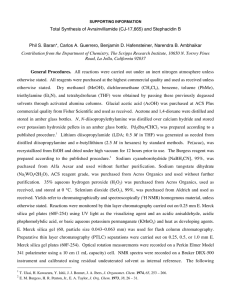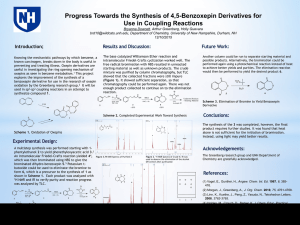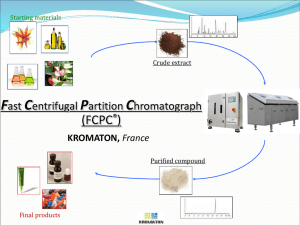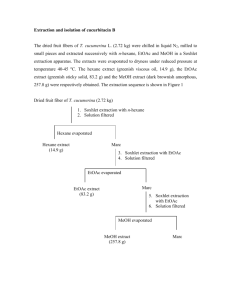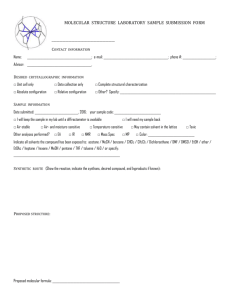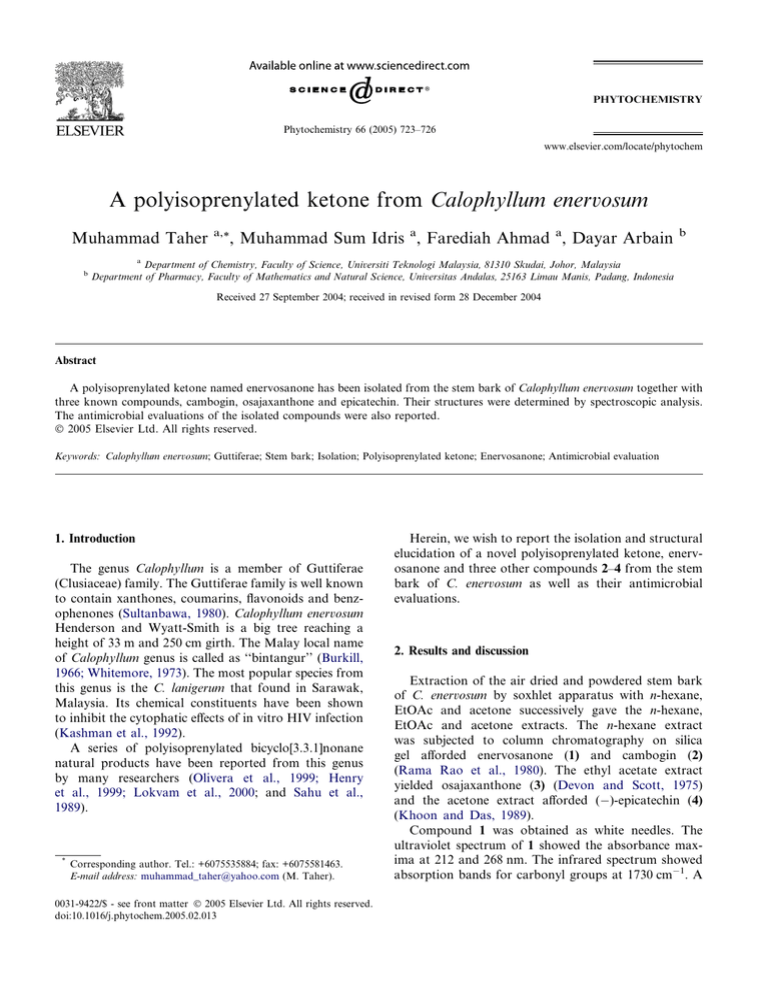
PHYTOCHEMISTRY
Phytochemistry 66 (2005) 723–726
www.elsevier.com/locate/phytochem
A polyisoprenylated ketone from Calophyllum enervosum
Muhammad Taher
a,*
, Muhammad Sum Idris a, Farediah Ahmad a, Dayar Arbain
b
a
b
Department of Chemistry, Faculty of Science, Universiti Teknologi Malaysia, 81310 Skudai, Johor, Malaysia
Department of Pharmacy, Faculty of Mathematics and Natural Science, Universitas Andalas, 25163 Limau Manis, Padang, Indonesia
Received 27 September 2004; received in revised form 28 December 2004
Abstract
A polyisoprenylated ketone named enervosanone has been isolated from the stem bark of Calophyllum enervosum together with
three known compounds, cambogin, osajaxanthone and epicatechin. Their structures were determined by spectroscopic analysis.
The antimicrobial evaluations of the isolated compounds were also reported.
2005 Elsevier Ltd. All rights reserved.
Keywords: Calophyllum enervosum; Guttiferae; Stem bark; Isolation; Polyisoprenylated ketone; Enervosanone; Antimicrobial evaluation
1. Introduction
The genus Calophyllum is a member of Guttiferae
(Clusiaceae) family. The Guttiferae family is well known
to contain xanthones, coumarins, flavonoids and benzophenones (Sultanbawa, 1980). Calophyllum enervosum
Henderson and Wyatt-Smith is a big tree reaching a
height of 33 m and 250 cm girth. The Malay local name
of Calophyllum genus is called as ‘‘bintangur’’ (Burkill,
1966; Whitemore, 1973). The most popular species from
this genus is the C. lanigerum that found in Sarawak,
Malaysia. Its chemical constituents have been shown
to inhibit the cytophatic effects of in vitro HIV infection
(Kashman et al., 1992).
A series of polyisoprenylated bicyclo[3.3.1]nonane
natural products have been reported from this genus
by many researchers (Olivera et al., 1999; Henry
et al., 1999; Lokvam et al., 2000; and Sahu et al.,
1989).
*
Corresponding author. Tel.: +6075535884; fax: +6075581463.
E-mail address: muhammad_taher@yahoo.com (M. Taher).
0031-9422/$ - see front matter 2005 Elsevier Ltd. All rights reserved.
doi:10.1016/j.phytochem.2005.02.013
Herein, we wish to report the isolation and structural
elucidation of a novel polyisoprenylated ketone, enervosanone and three other compounds 2–4 from the stem
bark of C. enervosum as well as their antimicrobial
evaluations.
2. Results and discussion
Extraction of the air dried and powdered stem bark
of C. enervosum by soxhlet apparatus with n-hexane,
EtOAc and acetone successively gave the n-hexane,
EtOAc and acetone extracts. The n-hexane extract
was subjected to column chromatography on silica
gel afforded enervosanone (1) and cambogin (2)
(Rama Rao et al., 1980). The ethyl acetate extract
yielded osajaxanthone (3) (Devon and Scott, 1975)
and the acetone extract afforded ()-epicatechin (4)
(Khoon and Das, 1989).
Compound 1 was obtained as white needles. The
ultraviolet spectrum of 1 showed the absorbance maxima at 212 and 268 nm. The infrared spectrum showed
absorption bands for carbonyl groups at 1730 cm1. A
724
M. Taher et al. / Phytochemistry 66 (2005) 723–726
band at 1607 cm1 was attributed to C@C stretching.
The bands at 2967, 2912 cm1 were assigned to C–H aliphatic stretching (Silverstein et al., 1991; Williams and
Fleming, 1995).
The 1H NMR of 1 showed the presence of two
tertiary methyl groups appearing at d 0.94 and 1.24,
seven olefinic methyl groups at d 1.64 (3H, s), 1.62
(3H, s), 1.61 (3H, s), 1.58 (3H, s), 1.54 (3H, s),
1.49 (3H, s) and 1.24 (3H, s). The C-3 gem methylene
protons appeared at d 2.93 (1H, d, J = 17.0 Hz) and
3.53 (1H, d, J = 17.0 Hz). Four triplet signals at d
5.13 (1H, t, J = 7.5 Hz), 4.98 (1H, t, J = 6.2 Hz),
4.90 (1H, t, J = 8.0 Hz), and 4.84 (1H, t, J = 6.6 Hz)
corresponding to olefinic protons indicated the presence of both isopent-2-enyl and geranyl groups in
the structure. The COSY spectrum of 1 showed the
connectivity of a triplet signal at d 5.13 and a doublet signal at d 2.47 (J = 7.5 Hz), other connectivity
could be shown between a triplet signal at d 4.98
and the multiplet signals at d 1.99 and 1.95. These
findings confirmed the presence of geranyl side chain,
which was attached to C-5. Two isoprenoid units
were readily identified from 1H, COSY and 13C
NMR spectra as 2-methylbut-2-enyl units that were
joined to C-1 and C-7.
The 13C NMR of 1 showed the presence of 31 carbons. The DEPT experiment confirmed that 1 contains
five methine carbons (at d 124.1, 122.6, 118.0, 117.4
and 46,4), seven methylene carbons at (d 62.8, 40.6,
39.9, 31.1, 29.2, 27.1 and 26.6), nine methyl carbons at
(d 26.3, 26.0, 25.7, 25.6, 22.9, 17.8, 17.8, 17.6 and 16.2)
and seven quaternary carbons at (d 139.1, 136.3, 133.5,
131.4, 70.2, 64.7 and 51.2). Three signals for carbonyl
groups were seen at d 210.3 and 202.7 (there were two
overlapping).
Compound 1 contains a bicyclo[3.3.1]nonane moiety,
which is commonly observed in the Guttiferae family
and the location of functionalities and ligands were deduced from the NMR data (Table 1).
In the EIMS spectrum, the molecular ion peak was
observed at m/z 466 corresponding to the molecular
formula of C31H46O3 (calculated for 466.34488). The
presence of nine degrees of unsaturation which consisted of four double bonds, three C@O groups and
two cyclic systems (Silverstein et al., 1991; Williams
and Fleming, 1995) confirmed that the compound
has a molecule as shown in structure 1. Cleavage of
1 to fragment m/z 329 indicated the elimination of geranyl side chain. A fragmentation ion at m/z 205
showed the cleavage of the non-ketone cyclic fragment
and the base peak at m/z corresponded to an isopent2-enyl group. When the 1H and 13C NMR spectral
data of 1 were compared with those of Guttiferone
B (5) as previously isolated by Gustafson et al.
(1992), it showed that they have a similarity in structure but lacked a benzoyl group.
Table 1
NMR spectral data of 1 (in CDCl3)
dCa
dH (int. mult. J)
1
1
2
3
70.2
202.7
62.8
–
–
H-3
4
5
6
202.7
64.7
40.6
7
8
9
10
11
12
13
14
15
16
17
18
19
20
21
22
23
24
25
26
27
28
29
30
31
46.4
51.2
210.3
26.6
118.0
133.5
22.9
26.0
25.6
17.6
29.2
122.6
136.3
26.3
16.2
31.1
117.4
139.1
39.9
17.8
27.1
124.1
131.4
25.7
17.8
–
–
2.93
3.53
–
–
1.30
1.43
2.04
Position
a
–
2.55
4.90
–
1.58
1.58
1.24
0.94
2.19
4.84
–
1.49
1.64
2.47
5.13
–
1.95
1.62
1.99
4.98
–
1.61
1.54
H–1H COSY
(1H, d, Jax = 17.0 Hz)
(1H, d, Jeq = 17.0 Hz)
–
–
H-6, H-7
(1H, m)
(1H, m)
(1H, m)
H-17, H-6
–
–
H-11
H-10, H-13, H-14
–
H-11, H-14
H-11, H-13
H-16
H-15
H-8, H-18
H-17, H-20, H-21
–
H-21, H-18
H-20, H-18
H-23
H-22, H-26
–
H-27
H-23
H-25, H-28
H-27, H-30, H-31
–
H-31, H-28
H-30, H-28
(2H, d, J = 8.0 Hz)
(1H, t, J = 8.0 Hz)
(3H,
(3H,
(3H,
(3H,
(2H,
(1H,
s)
s)
s)
s)
b dt)
t, J = 6.6 Hz)
(3H,
(3H,
(2H,
(1H,
s)
s)
d, J = 7.5 Hz)
t, J = 7.5 Hz)
(2H,
(3H,
(2H,
(1H,
m)
s)
m)
t, J = 6.2 Hz)
(3H, s)
(3H, s)
All carbon signals were assigned by the aid of DEPT experiments.
Table 2
Antibacterial activity of compounds 1, 2 and 3
Micro-organisms
B. subtilis
E. coli
P. aeruginosa
S. aureus
Inhibition zone in mm (MIC value in lg/lL)
1
2
3
12 (0.0125)
9.5 (0.0125)
11 (0.0125)
11.5 (0.0125)
8 (0.05)
–
8 (0.05)
8 (0.05)
–
–
–
–
4
Standard
n.a.
21 (3.9 · 104)
Ô–Õ: No activity against the tested bacteria; n.a.: not available; MIC:
minimum inhibition concentration; standard: streptomycin sulfate.
Antimicrobial assay was tested against two strain
bacteria, Gram-positive (Bacillus subtilis and Escherecia
coli) and Gram-negative (Pseudomonas aeruginosa and
Staphylococcus aureus) using the disc diffusion method.
As shown in Table 2, compound 1 was found to have
the strongest activity against four tested bacteria
although it is much less active than the positive control
streptomycin sulfate (MIC of 3.9 · 104 lg/lL). Compound 2 was found to be inactive against S. aureus
and compound 4 was found to be inactive against all
tested bacteria.
M. Taher et al. / Phytochemistry 66 (2005) 723–726
13
14
21
15
16
OH
17
O
725
8
1
H 3
H
O6
HO
20
H
O
O
9
22
5
O
O
30
25
O
27
31
26
2
1
O
OH
OH
HO
O
HO
O
O
OH
OH
OH
3
4
OH
HO
O
O
O
OH
5
3. Experimental
(MT-03) is deposited at the Herbarium of Universitas
Andalas (AND), Padang, Indonesia.
3.1. General experimental procedures
Melting points were determined by using a Leica
Gallen III apparatus and were uncorrected. UV spectra were measured on UV-100PC Shimadzu using
methanol solution. IR spectra were measured on a
FT-IR Perkin–Elmer 1600 as KBr discs. Optical rotations were measured by a Polarimeter Type AA-5. 1H
NMR (400 MHz) and 13C NMR (100 MHz) spectra
were recorded on a Varian Unity INOVA spectrophotometer, using TMS as internal standard. EIMS were
recorded on a Varian mass spectrometer at 70 eV.
CC: silica gel (Merck 70–230 mesh and 230–400 mesh).
Spots were visualized by UV (254 and 365 nm), FeCl3
and p-anisaldehyde spraying reagent. Streptomycin sulfate standard was purchased from Oxoid (Hampshire,
UK).
3.2. Plant material
Stem bark of C. enervosum was collected from Tilatang Kamang, 6 km East of Bukittinggi, West Sumatra,
Indonesia in September 1998. The voucher specimen
3.3. Extraction and isolation
The dried and powdered of the stem bark of C.
enervosum (950 g) was extracted by soxhlet extractor
for 18 h with n-hexane (2.5 L), EtOAc (2.5 L) and
acetone (2.5 L) successively. Each solvent was removed
under reduced pressure by rotary evaporator. The nhexane extract (31.7 g, 3.33%), EtOAc extract (12.7 g,
1.33%) and acetone extract (16 g, 1.68%) all gave a
sticky brown liquid.
The n-hexane extract (30 g) was separated by column
chromatography (60 cm · 6 cm i.d.) on silica gel 70–230
mesh (Merck) (150 g) and eluted with petrol, petrol–
EtOAc (9:1), (8:2), (7:3), (6:4), (5:5), (2:8) and EtOAc
to give fractions A, B, C, D, E, F and G. Then, fraction
C (5.2 g) was repeatedly purified by column chromatography (42 cm length, 3.5 cm diameter) on silica gel 70–
230 mesh (80 g) using the same solvent system giving
fractions C1, C2, C3 and C4.
The combined fraction C2 was subjected to column
chromatography (35 cm length, 2.5 cm diameter) on
silica gel 230–400 mesh (60 g) eluting with petrol,
726
M. Taher et al. / Phytochemistry 66 (2005) 723–726
petrol–EtOAc (9:1), (8:2), (7:3), (6:4), (5:5), (4:6), (2:8),
(1:9) and EtOAc. Fraction with the same Rf values were
combined and washed with petrol to yield 1 as white
needles (341.1 mg).
Fraction D (1.7 g) was purified by column chromatography (35 cm · 2.5 i.d.) on silica gel 70–230 mesh
(80 g), eluted with n-hexane–EtOAc (9:1) (8:2) (7:3),
(6:4) (5:5), (4:6), EtOAc, and EtOAc–MeOH (9:1) afforded fractions D1, D2 and D3. Fraction D3 was repeatedly washed with Et2O to afford 2 as pale yellow cubes
(249.1 mg).
Separation of the EtOAc extract (10 g) by column
chromatography (42 cm · 3.5 cm i.d.) over silica gel 70–
230 mesh (100 g) and elution with petrol–EtOAc (9:1),
(8:2), (7:3), (6:4), (5:5), (4:6), EtOAc, and EtOAc–MeOH
(9:1, 8:2) afforded fractions H, I, J, K and L. Purification
of fraction I by preparative thin layer chromatography
(1 mm layer thickness) eluted with petrol–EtOAc (7:3)
yielded 3 as yellow needles (7.4 mg).
The acetone extract (10 g) was purified by vacuum liquid chromatography (7.5 cm · 7.5 cm i.d.). Silica gel
230–400 mesh (100 g) was used as stationary phase. It
was eluted with Et2O, EtOAc and acetone successively
giving three fractions. The EtOAc soluble fraction was
separated by column chromatography (35 cm · 2.5 cm
i.d.) on silica gel 70–230 mesh (60 g), eluting with petrol–EtOAc (9:1), (8:2), (7:3), (6:4), (5:5), (4:6), (3:7),
(2:8), EtOAc, and EtAOc–MeOH (9:1), (8:2), and (7:3)
to give fractions M, N and O. Fraction N was repeatedly
washed with acetone to give 4 as white plate crystals
(850 mg).
3.4. Antimicrobial assay
The isolated compounds from the stem bark of
C. enervosum were tested against micro-organisms,
B. subtilis, E. coli, P. aeruginosa and S. aureus. The antimicrobial assay was carried out according to Zavala et al.
(1997), the paper discs were impregnated with 10 lL of
methanol solution of each sample (1 mg/mL) and allowed
to evaporate at room temperature. Streptomycin sulfate
(30 lg/disc) was used as standard positive control. The
discs were then incubated on the plate containing micro-organism at 37 C for 18 h. The diameter of inhibition zone around each disc was measured and recorded
at the end of the incubation period.
3.5. 8,8-Dimethyl-5-geranyl-1,7-bis(3-methylbut-2enyl)bicyclo[3.3.1]nona-2,4,9-trione (1)
White needles, m.p. 119–120 C. TLC (silica gel): Rf
24
0.67 in EtOAc: CHCl3 (1:1). ½aD þ10 (MeOH; c
MeOH
0.2000). UV kmax nm (log e): 212 (2.18) and 268
1
(1.86). IR vKBr
max cm : 2967, 2912 (C–H aliphatic), 1730
(C@O), 1607 (C@O), and 1531 (C@C). 1H NMR
(400 MHz, CDCl3) see Table 1.13C NMR (100 MHz,
CDCl3) see Table 1. EIMS: m/z [M]+ 466 for
C31H46O3 (calculated 466.34488), 329 (30), 261 (22),
205 (50), 135(18), 109 (38), 81(50), 69 (100), and 41 (76).
Acknowledgments
This research work was supported by a grant from
IRPA Malaysia under vote Project No. 72053. Thanks
are due to Mr. Rusjdi Tamin at the Herbarium of Universitas Andalas, Padang for identifying the plant material. The authors are grateful to Assoc. Prof. Roger W.
Read at the Department of Chemistry, University of
New South Wales, Australia for the EIMS measurement.
References
Burkill, I.H., 1966. A Dictionary of the Economic Products of the
Malay Peninsula. Government of Malaysia and Singapore by the
Ministry of Agriculture and Co-operatives, Kuala Lumpur,
Singapore, pp. 410–417.
Devon, T.K., Scott, A.I., 1975Handbook of Naturally Occurring
Compounds, vol. I. Academic Press, New York, pp. 298.
Gustafson, K.R., Blunt, J.W., Munro, M.H.G., Fuller, R.W., Mckee,
T.C., Cardellina II, J.H., McMahon, J.B., Cragg, G.M., Boyd,
M.R., 1992. The guttiferones, HIV-inhibitory benzophenones from
Symphonia globulifera, Garcinia livingstonei, Garcinia ovalifolia and
Clusia rosea. Tetrahedron 48, 10093–10102.
Henry, G.E., Jacobs, H., Carrington, C.M.S., McLean, S., Reynolds,
W.F., 1999. Prenylated benzophenone derivatives from Caribbean
Clusia species (Guttiferae). Pluketiones B–G and xerophenone A.
Tetrahedron 55, 1581–1596.
Kashman, Y., Gustafson, K.R., Fuller, R.W., Cardellina II, J.H.,
McMahon, J.B., Currens, M.J., Buckheit Jr., R.W., Hughes, S.H.,
Cragg, G.M., Boyd, M.R., 1992. The calanolides, a novel HIVinhibitory class coumarin derivaties from the tropical rainforest
tree, Calophyllum lanigerum. Journal of Medicinal Chemistry 35,
2735–2743.
Khoon, H.L., Das, N.P., 1989. Production of ()-epicatechin by
Uncaria elliptica callus cultures. Phytochemistry 28, 1099–1100.
Lokvam, J., Braddock, J.F., Reichardt, P.B., Calusen, T.P., 2000. Two
polyisoprenylated benzophenones from the trunk latex of Clusia
grandiflora (Clusiaceae). Phytochemistry 55, 29–34.
Olivera, C.M.A., Porto, A.L.M., Bittrich, V., Marsaioli, A.J., 1999.
Two Polyisoprenylated benzophenones from the floral resins of
three Clusia species. Phytochemistry 50, 1073–1079.
Rama Rao, A.V., Venkatswamy, G., Pendse, A.D., 1980. Camboginol
and cambogin. Tetrahedron Letters 21, 1975–1978.
Sahu, A., Das, B., Chatterjee, A., 1989. Polyisoprenylated benzophenones from Garcinia pedunculata. Phytochemistry 28, 1233–1235.
Silverstein, R.M., Bassler, G.C., Morril, T.C., 1991. Spectrometric
Identification of Organic Compounds, fifth ed. Wiley, Singapore,
pp. 91–102.
Sultanbawa, M.U.S., 1980. Xanthonoids of tropical plants. Tetrahedron 36, 1465–1506.
Whitemore, T.C., 1973. Tree Flora of Malaya, vol. 2. Longman,
London, pp. 162–235.
Williams, D.H., Fleming, I., 1995. Spectroscopic Methods in Organic
Chemistry, fifth ed. The McGraw-Hill Companies, London, pp.
28–57.
Zavala, S.M.A., Perez, G.S., Perez, G.M., 1997. Antimicrobial
screening of some medicinal plants. Phytotheraphy Research 11,
368–371.


